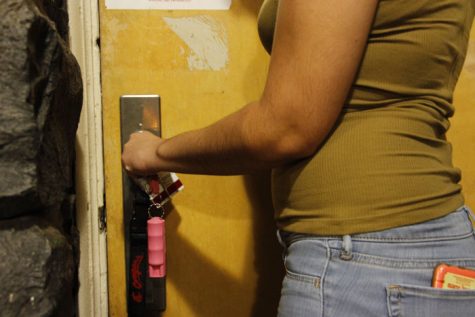Indoor plants can have health benefits
Designers and scientists say access to nature can improve mood, well-being
SAMANTHA DOHRMAN | THE DAILY EVERGREEN
Chris Chandler of Neill’s Flower Shop talks about terrariums and how to care for them.
January 25, 2018
Bringing nature indoors through house plants and natural light can have an assortment of benefits, from increasing productivity to creating a calmer environment.
Graduate interior design student Sharla Thiesen focuses on designing and researching nature-filled medical facilities, said biophilia — a concept coined by E. O. Wilson to explain humankind’s desire to connect with nature — can be used to improve work and home environments.
“Basically,” she said, “it’s in our DNA to have that connection.”
She pointed to current research, such as an overview of 50 studies published in the National Institute of Health by Bjorn Grinde and Grete Grindal Patil, which found that areas devoid of nature can create negative environments. The studies show that well-placed potted plants, a view of the outdoors through a window, and easy access to parks and natural areas can have medical and mood benefits.
She also used a more specific example, from a study that inspired much of the focus in her recent graduate work. Researchers found that patients who had a view of nature through a window, instead of a brick wall, recovered from surgery faster.
Thiesen, who is also a breast cancer survivor, said she’s seen the healing effects of connecting with nature demonstrated in her own recovery.
Chris Chandler, the special projects manager at Neill’s Flowers in Pullman, recommended students choose plants that thrive on neglect. A few suggestions he had included cacti, which often die from over watering, peace lilies, parlor palms and scheffleras, all of which can thrive with little maintenance.
Beyond their visual benefits, Chandler also said easily available green, leafy plants can filter and freshen the air in many apartments. He pointed to a NASA study in which scientists found that common house plants, like ficus, Chinese evergreens and bamboo palms can filter harmful chemicals such as benzene, trichloroethylene and formaldehyde from the air.
He said many common houseplants are taken from tropical areas, and a plant in the bathroom can receive much of the water it needs from shower steam. He also suggested slow watering methods, like leaving an ice cube on the roots.
“Most of the basic green plants will do better when they aren’t being over-cared for,” he said. “A lot of people think you need to water them a couple of times per week, but that’ll cause their roots to rot and they just start dying because they’re floating.”
He added that often, the biggest problem for college student plant owners was forgetting about them over break. With the exception of cactuses and other desert varieties, two or three weeks without water kills most green, leafy plants. He suggests soaking the roots in a few inches of water in a sink before leaving, and ensuring they are not too close to any windows, which would quickly dry them out.
Thiesen recommended having houseplants visible in workspaces and apartments, and trying to find a way to be near windows during the day. If bringing nature inside isn’t a possibility, she suggests students find a favorite spot on campus or in their neighborhood to go to connect with nature.
“Get as much light as you can,” she said. “If you can’t get to those plants, bring [them] in. Have that connection.”



















